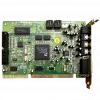ISA (Industry Standard Architecture) originated as an 8-bit system in the IBM PC in 1981, and was extended in 1983 as the XT bus architecture. The modern 16-bit standard was introduced in 1984. Designed to connect peripheral cards to the motherboard, the protocol also allows for bus mastering although only the first 16 MB of main memory is available for direct access. The 8-bit bus ran at 4.77 MHz, while the 16-bit bus operated at 8 MHz. In reference to the XT bus, it is sometimes referred to as the AT bus architecture. It was also available on some non-IBM compatible machines such as the short-lived AT&T Hobbit and later PowerPC based BeBox.
In 1987, IBM moved to replace the ISA bus with their proprietary Micro Channel Architecture (MCA) in an effort to regain control of the PC architecture, and the PC market. The system was far more advanced than ISA, and computer manufacturers responded with the Extended Industry Standard Architecture (EISA) and later, the VESA Local Bus (VLB). In fact, VLB used some parts originally intended for MCA due to the fact that component manufacturers already had the ability to manufacture it. Both were compatible expansions of the ISA standard. Neither became extraordinarily popular, however, and were soon succeeded by Intel's 32-bit Peripheral Component Interconnect (PCI).
Users of ISA-based machines had to know special information about the hardware they were adding to the system. While a handful of devices were essentially "plug-n-play," this was rare. Users frequently had to configure two or three things when adding a new device, such as the IRQ line, I/O address, or DMA channel. MCA had done away with this complication, and PCI actually incorporated many of the ideas first explored with MCA (though it was more directly descended from EISA).
This trouble with configuration eventually led to the creation of ISA PnP, a plug-n-play system that used a combination of modifications to hardware, the system BIOS, and operating system software to automatically manage the nitty-gritty details. In reality, ISA PnP turned out to be a major headache much of the time, and didn't become well-supported until the architecture was in its final days. This was a major contributor to the use of the phrase "plug-n-pray."
PCI slots were the first physically-incompatible expansion ports to directly squeeze ISA off of the motherboard. At first, motherboards were largely ISA, including a few PCI slots. By the mid-1990s, the two slot types were roughly balanced, and ISA slots soon were in the minority on consumer systems. Microsoft's PC 98 specification recommended that ISA slots be removed entirely, though the system architecture still required ISA to be present in some vestigial way internally to handle the floppy drive, serial ports, etc. ISA slots remained for a few more years, and it was even possible to see systems with an Accelerated Graphics Port (AGP) sitting near the central processing unit, an array of PCI slots, and one or two ISA slots near the end.
It is also notable that PCI slots are "rotated" compared to their ISA counterparts—PCI cards were essentially inserted "upside-down," allowing ISA and PCI connectors to squeeze together on the motherboard. Only one of the two connectors can be used in each slot at a time, but this allowed for greater flexibility.






